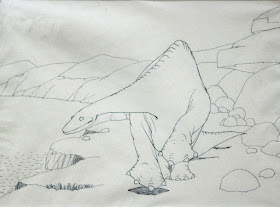The possessions would have to be auctioned off to pay Rembrandt's debts. Moving from room to room, it didn't take long to figure out why Rembrandt had gone bankrupt. As Anthony Bailey wrote in his book, Rembrandt's House:
The house was crammed with pictures, stacked against and hanging from the walls.... [T]he collecting trait appears to have become an ungovernable compulsion.Bailey reports that these pictures included "bits and pieces," scraps and sketches that Rembrandt fancied by his contemporaries, drawings from Italy, paintings from different periods in a variety of styles.
In part he collected... pieces that he could use in his works, not just for themselves but as pointers and touchstones. [B]ut his collection of pictures was huge and diverse. Rembrandt's collection was almost a museum.I thought about poor bankrupt Rembrandt recently when I viewed the current exhibition at the Society of Illustrators of the art collection of the illustrator Peter de Sève. The exhibition includes work from greats such as Rackham, Searle, Kley, Frazetta, Frost, Sullivant, Disney artists, Winsor McCay and many others.
Unlike a typical museum exhibition organized by a curator or art historian, de Sève has assembled work that appeals to his artist's eye.
He includes working drawings that reveal the thought processes of the artist:
 |
| Jules Feiffer |
Preliminary sketches that reveal the original spark of inspiration before the concept has been refined and diminished.
 |
| Frazetta |
 |
| Frazetta |
 |
| A dog racing down the road... |
 |
| ...leaves disaster in its wake. |
and moving on to Winsor McCay's Gertie the Dinosaur at the dawn of animation...
...before turning to great Disney art such as Preston Blair's famous hippopotamus ballerina from Fantasia and art from Lilo and Stitch.
There's strong pen and ink work by artists such as Heinrich Kley:
... and work by Arthur Rackham that reveals the artist's underlying sensitive pencil lines:
 |
The exhibition also contains final work with interesting solutions by fellow illustrators:
 |
| As fearless with watercolor as he is with ink. |
 |
| Valentine from de Sève's daughter Paulina when she was five years old. |
Paulina's picture exemplifies what makes an artist's exhibition so interesting. De Sève isn't misled by the pretensions and superficial considerations that preoccupy so many curators and art historians. Instead, he hones right in on the nutritional content; all marks on paper are judged on a level playing field.
At the entrance to the exhibit, De Sève writes: "The artist I've become is a result of the things I've learned, and continued to learn, from others."
When the Amsterdam Insolvency Office finally shows up at de Sève's door, you'll want to be there for the auction.






Donato Giancola put a video up of a brief visit to De Seve's studio on the Muddy Colors web site a few months back. The glimpses of the art on De Seve's studio walls had my mouth watering, as does your post.
ReplyDeleteAwesome art!
ReplyDeleteI stopped visiting the Society of Illustrators when they went all digital but this is something I'll go back for. Looks like a neat exhibit.
ReplyDeleteJSL
I like the first Frazetta sketch. Is there a finished painting corresponding to it?
ReplyDeleteIbrahim R. Ineke-- Yes, this is an excellent example of my point. That Frazetta study ended up as the final painting, Death Dealer VI: http://www.museumsyndicate.com/item.php?item=25101 . I think the prelim is far superior.
ReplyDeleteRobert Cosgrove-- None of these photographic treatments do justice to the originals. If you're in the vicinity of New York City I recommend a visit.
MORAN-- Definitely.
Anonymous / JSL-- It hasn't "all gone digital" but digital or not, I find the Society is always worth a visit. This particular show is only up for a couple of weeks longer.
For eight years, from around 1985 to 1993 Frazetta was suffering from a variably dysfunctional thyroid that, at times, put him in excruciating pain that nearly led him to suicide. It took a long time for the doctors to figure out how to treat it properly and consistently (He would rally for short periods, then fall back into illness again).
ReplyDeleteThe Death Dealer VI sketch appeared in Frazetta Book Five which was put together by late 1984, which seems to be before the illness hit. Meanwhile, the Death Dealer VI painting based on that great sketch seems to have been painted during his period of prolonged illness and, I think, shows quite clearly how his thyroid dysfunction debilitated his imagination.
Kev Ferrara-- That's an interesting take on the finished version of the Death Dealer painting. I'd read about Frazetta's illness but I never placed it on a timeline with these two pictures. The finished version of the painting has, in my view, some truly terrible moments; we spend so much time thinking about what goes into excellent art, but no one ever says "a properly balanced thyroid."
ReplyDeleteThank you for posting these. If there is a desire for a final piece to be ‘seamless’, these are wonderful examples of how that is arrived at. It is such a valuable exercise for all artists to witness the process of getting to ‘seamless’ — and sometimes early sketches are far more interesting and energetic. Tom Fluharty’s book, “Art of the Sketch” is a great example of the energy and freedom of beginning the process. I think it is particularly important now to see these since tight turnaround times demand that illustrations have to be done done digitally. Getting a sense of the artist’s hand becomes even more exciting and humanizing.
ReplyDeleteLovely post David, thank you.
ReplyDeleteI particularly like the two Frost drawings and especially the Arthur Rackham.
Obviously preliminary paintings, drawings and sketches are cheaper, but I wonder if Peter De Seve had a particular taste for embryonic work?
JSL what do you mean they went all digital??
ReplyDelete